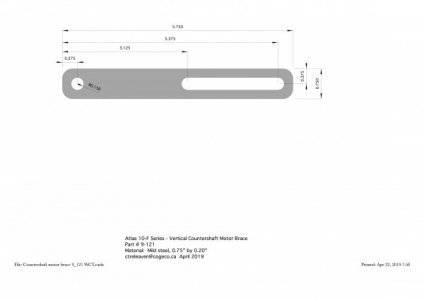- Joined
- Oct 10, 2018
- Messages
- 545
My alternative is to hacksaw and file but I made a DIY milling attachment for my little Atlas 618 lathe and all I need to do is cut a simple slot in a piece. I've watched quite a few Youtube videos but have no practical experience with any kind of milling machine. So I'd appreciate some step-by-step advice.
I want to make the slot in this:

I'm using this:

 www.hobby-machinist.com
www.hobby-machinist.com
but I've gotten a proper milling cutter holder since that thread was posted. I'd intended to practise with some aluminum to get experience but need the steel part for an Atlas 10-F that I'm fixing.
The slot should be 5/16" wide and 2.25" from end to end in mild steel that is 0.200" thick. My thought is to drill 5/16" holes at either end. First, I'd planned to use my drill press, but the holes would be pretty precisely aligned if I do them with the lathe milling attachment. Any problems with that approach?
After drilling, I plan to switch to a 1/4" milling cutter. I have both 4-flute and 2-flute 1/4" end mills. Is the 4-flute preferred for faster cutting? The LittleMachineShop calculator says 1,380 RPM. Of course, I don't have power feed.
I'm thinking to start in the drilled hole at one end and slowly, using cutting oil, plow a full depth slot to the other end, down the middle. 5/16" minus 1/4" leaves 1/16" total or 1/32" on either side. So then I'll make a pass to mill the 1/32" off one side of the slot--conventional milling direction; not climb-milling. Finally cut the other 1/32" off the other side of the slot, again in conventional milling direction.
Are these cuts going to be too aggressive? I'm prepared to be patient and nibble away.
Any major red flags? I'm planning safety glasses and a face shield in case a cutter decides to become shrapnel!
Craig
I want to make the slot in this:

I'm using this:

My DIY Atlas 618 milling attachment
Hey! I made diy milling attachment for my tiny Atlas 618 lathe!! I don't have a mill and acquiring one is not in the cards for the foreseeable future. But then I ran across Harold Hall's amazing website and the idea of using an angle plate to enable the compound to move a vise in the vertical...
 www.hobby-machinist.com
www.hobby-machinist.com
but I've gotten a proper milling cutter holder since that thread was posted. I'd intended to practise with some aluminum to get experience but need the steel part for an Atlas 10-F that I'm fixing.
The slot should be 5/16" wide and 2.25" from end to end in mild steel that is 0.200" thick. My thought is to drill 5/16" holes at either end. First, I'd planned to use my drill press, but the holes would be pretty precisely aligned if I do them with the lathe milling attachment. Any problems with that approach?
After drilling, I plan to switch to a 1/4" milling cutter. I have both 4-flute and 2-flute 1/4" end mills. Is the 4-flute preferred for faster cutting? The LittleMachineShop calculator says 1,380 RPM. Of course, I don't have power feed.
I'm thinking to start in the drilled hole at one end and slowly, using cutting oil, plow a full depth slot to the other end, down the middle. 5/16" minus 1/4" leaves 1/16" total or 1/32" on either side. So then I'll make a pass to mill the 1/32" off one side of the slot--conventional milling direction; not climb-milling. Finally cut the other 1/32" off the other side of the slot, again in conventional milling direction.
Are these cuts going to be too aggressive? I'm prepared to be patient and nibble away.
Any major red flags? I'm planning safety glasses and a face shield in case a cutter decides to become shrapnel!
Craig
